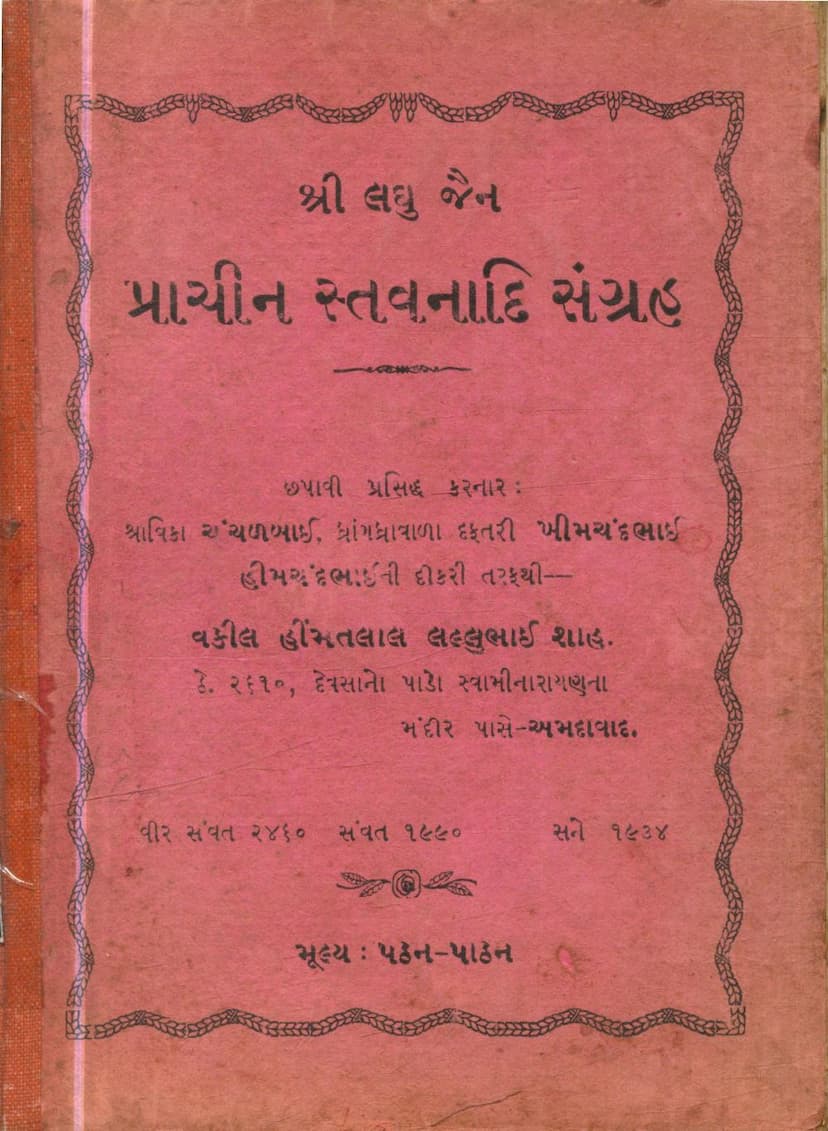Prachin Stavanadi Sangraha
Added to library: September 2, 2025

Summary
Here's a comprehensive summary of the Jain text "Prachin Stavanadi Sangraha" based on the provided pages:
Book Title: Prachin Stavanadi Sangraha (Collection of Ancient Stanzas, etc.) Author/Publisher: Himmatlal Lallubhai Shah Publication Year: Vira Samvat 2460 (1934 CE)
Overview:
"Prachin Stavanadi Sangraha" is a collection of ancient Jain devotional hymns, prayers, and philosophical compositions. It was compiled and published by Himmatlal Lallubhai Shah, with the publication being sponsored by Shravika Chanchalbai, daughter of Dafteri Khimchandbhai Hemchadbhai of Dhrangadhra, in memory of her. The book was printed at Shri Virvijay Printing Press in Ahmedabad.
Key Contents and Themes:
The Sangraha is meticulously organized, featuring a detailed index of its contents, which are primarily devotional songs (Stavans) and narrative hymns (Sajzay). The collection aims to provide spiritual nourishment and guidance for devotional practice and contemplation.
Major Sections and their Significance:
-
Chaitra Vandan (Temple Worship): The collection begins with various Chaitya Vandan, which are prayers directed towards specific Tirthankaras and revered deities. These include:
- Shri Shankheshwar Parshvanathji: A prominent deity in Jainism, particularly revered for overcoming obstacles. The Vandan emphasizes devotion to Parshvanath, urging followers to turn away from worldly distractions and false deities.
- Shri Shantinathji: The sixteenth Tirthankara, whose name signifies peace. The Vandan focuses on the removal of suffering and the attainment of peace through devotion.
- Shri Parmeshthi (Nava Pad): The Five Supreme Beings (Arihant, Siddha, Acharya, Upadhyaya, Sadhu), who are central to Jain meditation and devotion. The Vandan highlights their protective and beneficial powers.
- Shri Chandraprabhuji: The eighth Tirthankara, associated with auspiciousness and illumination.
- Shri Parshvanathji (Teva): Likely a hymn or prayer specifically to Parshvanath.
- Shri Navpad Swadhyay: A spiritual discourse or study related to the Nine Sacred Entities (Navapada) in Jainism.
-
Stavana (Devotional Hymns): This section contains numerous hymns dedicated to various aspects of Jain philosophy and to different Tirthankaras:
- Shri Panch Karan nu Stavan: Hymns on the Five Causes or Principles, likely referring to the five core tenets of Jainism.
- Shri Samkit nu Stavan: Hymns on Right Faith (Samyak Darshan), a crucial step towards liberation. The text emphasizes its importance and the correct understanding of spiritual principles.
- Hymns to Rishabhdevji (Adinath): The first Tirthankara, praised for his establishment of the Jain order and his role in societal development.
- Hymns to Mallinath Jin: The nineteenth Tirthankara, who is unique for being a female Tirthankara.
- Hymns to Mahavir Swami: The twenty-fourth Tirthankara, revered for his teachings on non-violence and liberation. The collection includes hymns on his Panch Kalyanaka (five auspicious events) and his 27 lives.
- Athai nu Stavan: Hymns related to an eight-day festival or observance.
- Shri Godiji Parshvanath nu Stavan: A specific devotional piece to Parshvanath, possibly related to a particular shrine.
- Agiyaras nu Stavan: Hymns associated with the eleventh day of the lunar fortnight.
- Vis Dandak nu Stavan: Hymns related to the twenty classes of beings or elements in Jain cosmology.
- Shri Jambuswami na Dhaliya: Hymns recounting the life and teachings of Jambu Swami, the first GANADHARA (chief disciple) of Mahavir Swami.
- Pancham nu Stavan: Hymns related to the fifth day of the lunar fortnight.
- Shri Diwali nu Stavan: Hymns for the festival of Diwali, a significant occasion in Jainism.
-
Sajzay (Narrative Hymns): This section features narrative hymns that often recount stories of past lives, devotional acts, and spiritual insights:
- Shri Krishna Maharaj ni Sajzay: A narrative hymn about Lord Krishna, likely viewed through a Jain philosophical lens.
- Shri Dhannaji ni Sajzay: A story of Dhanna, a righteous individual known for his detachment.
- Samkit na Sad-sath Bol ni Sajzay: A hymn detailing sixty-six principles or aspects of Right Faith.
- Shri Vijay Seth ne Vijayarani ni Sajzay: A story of a merchant and his wife, highlighting their virtues and devotion.
- Shri Sal Supna ni Sajzay: A hymn about beautiful dreams, possibly related to auspicious visions.
- Shri Shan Nar ni Sajzay: A hymn about a virtuous king or person.
- Shri Marg Vahe Utavalo, etc.: Various other narrative hymns covering diverse spiritual themes.
- Samsar Swarup ni Sajzay: A hymn describing the nature of the cycle of birth and death.
- Aath Drishti ni Sajzay: Hymns related to the eight types of vision or understanding.
- Dhanasha ni Sajzay: A hymn about Dhanshahu, a wealthy philanthropist.
- Gautam Swami ne Ras: A narrative hymn about Gautam Swami, the chief disciple of Mahavir Swami.
- Shri Shantinath Swami ne Chhand: A metrical composition in honor of Shantinath.
Spiritual and Philosophical Underpinnings:
The collection emphasizes key Jain principles such as:
- Ahimsa (Non-violence): The foundational principle of Jainism, implicitly woven into the devotional practices.
- Samyak Darshan (Right Faith): The importance of correct understanding and belief in Jain tenets.
- Detachment from Worldly Affections: Many hymns urge followers to transcend worldly desires and attachments.
- Devotion to Tirthankaras: The primary focus is on seeking blessings and spiritual guidance from the enlightened beings.
- Karma Theory: The concept of karma and its role in shaping one's destiny is often alluded to.
- The Path to Liberation (Moksha): The ultimate goal of Jain spiritual practice, which is attained through virtuous conduct, knowledge, and faith.
Significance of the Collection:
"Prachin Stavanadi Sangraha" serves as a valuable repository of Jain devotional literature. It preserves ancient hymns and practices that are essential for the spiritual development of Jains. The collection's organization and the inclusion of detailed indices make it a practical resource for monks, nuns, scholars, and lay followers seeking to deepen their understanding and connection to Jain traditions. The sponsorship by Shravika Chanchalbai highlights the active role of laywomen in preserving and promoting Jain heritage.